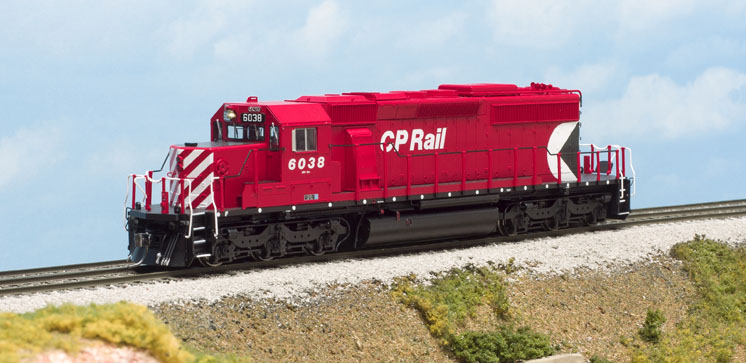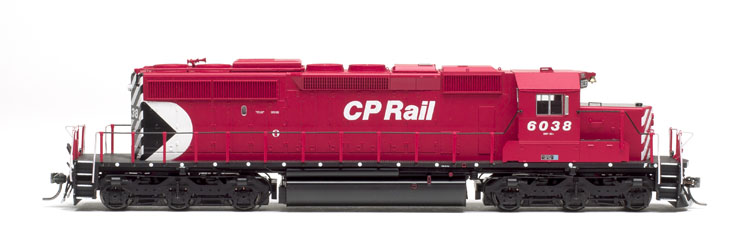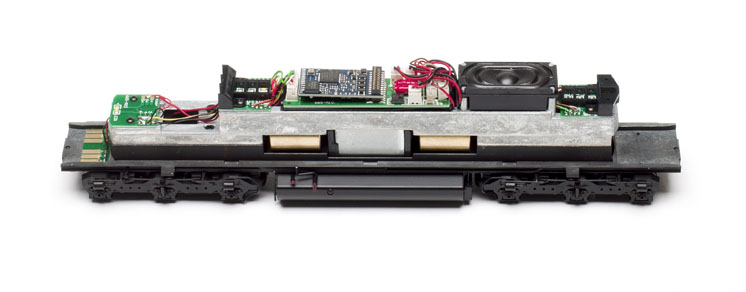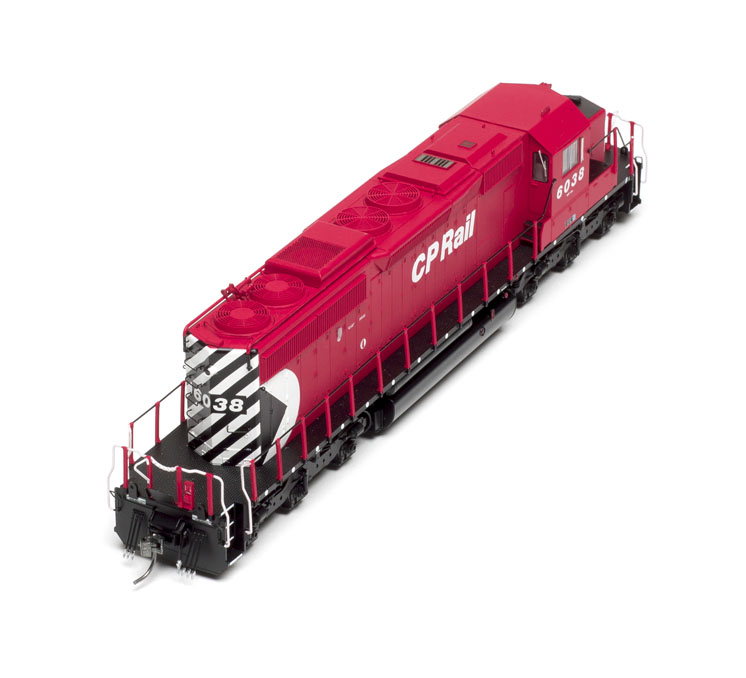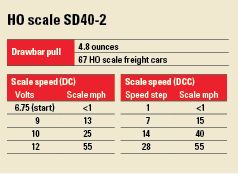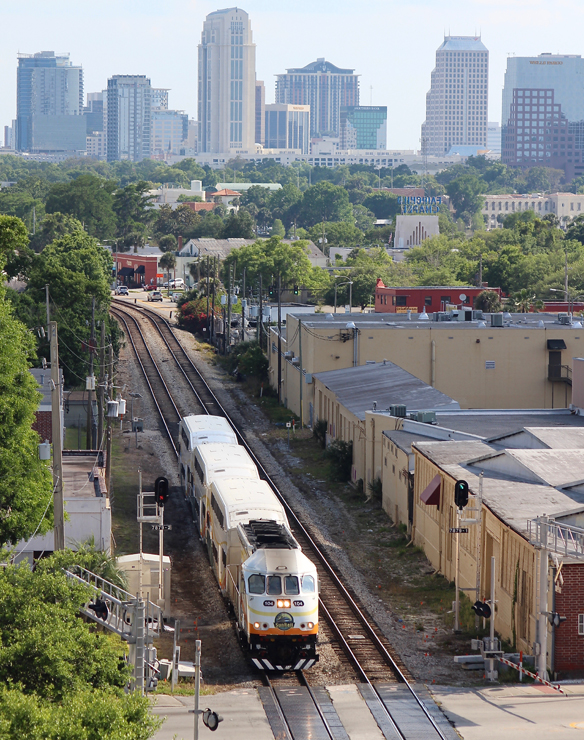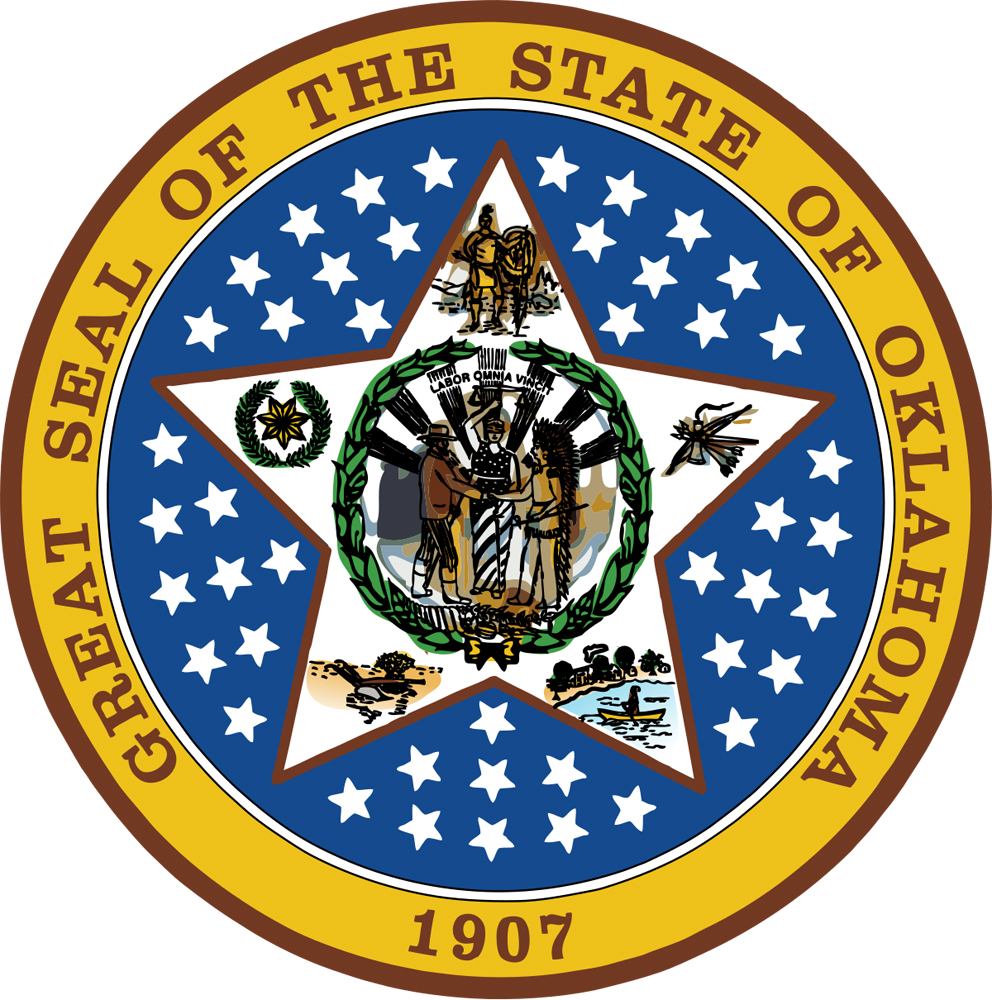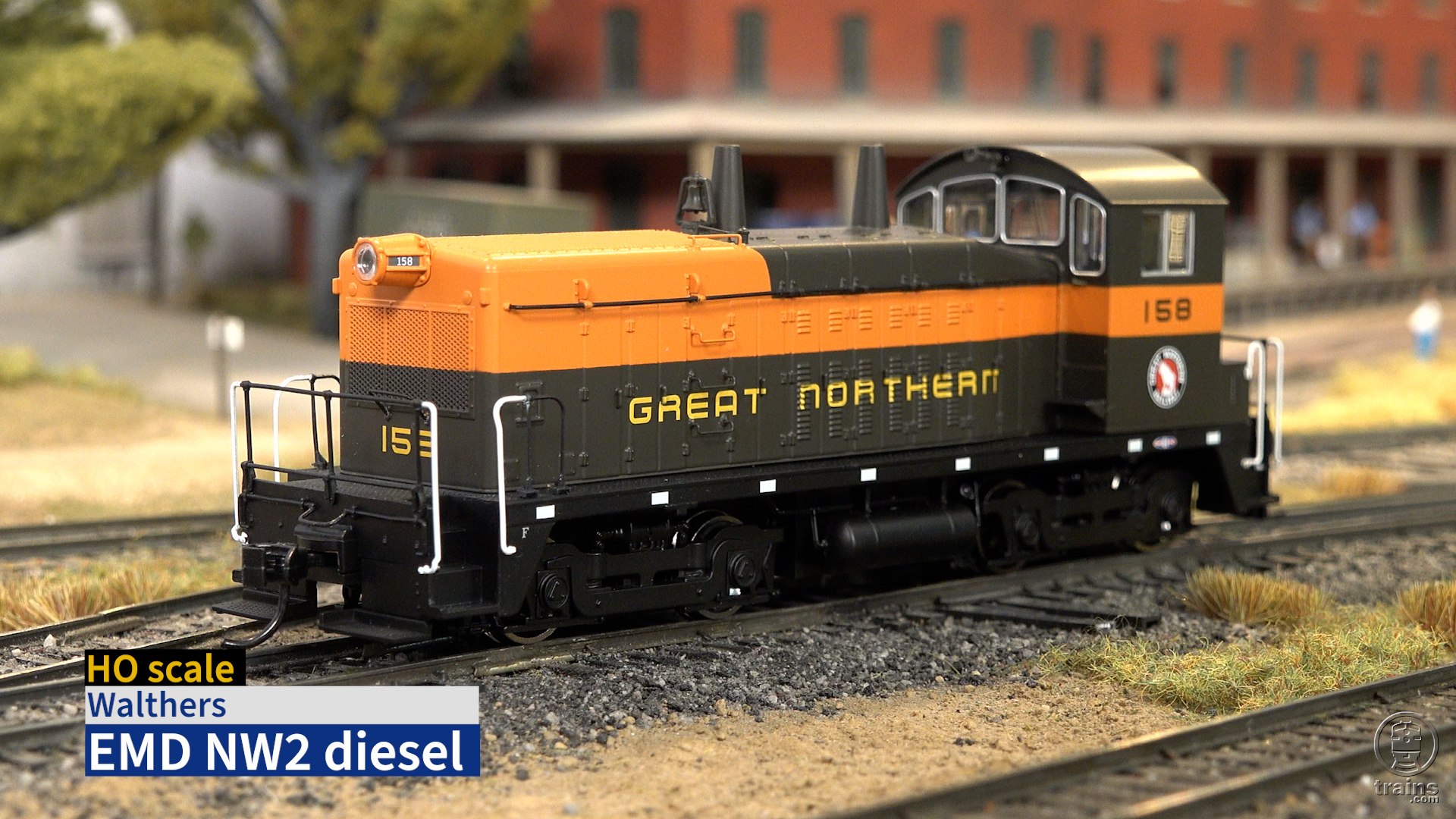More than a generic Electro-Motive Division SD40-2 painted in Canadian railroad colors, this newly tooled HO scale SD40-2 from Bowser Trains is detailed to match its CP Rail prototype. Our review sample, CPR no. 6038, is part of the first run of Bowser’s General Motors Diesel Division (GMDD) SD40-2s. Although this run is sold out at Bowser, many are still available on hobby shop shelves. A second run of prototype-specific models is in production.
The prototype. Introduced in 1972, the 3,000 hp SD40-2 received 40 component upgrades to increase reliability and efficiency over its predecessor, the SD40. These included improvements to the turbocharged 16-cylinder 645E3C prime mover and D77 traction motors, as well as the introduction of high-adhesion HT-C trucks. Like other locomotives in EMD’s Dash 2 line, the SD40-2 received a solid-state electrical control system.
Most of the 3,982 SD40-2 locomotives were built at EMD’s plant in LaGrange, Ill. General Motors Diesel Division, a GM subsidiary with a plant in London, Ontario, built 684 SD40-2s for the Canadian market. Canadian Pacific (later CP Rail) received its first SD40-2 from EMD in 1972, but most of its 486 SD40-2s came from GMDD and still serve today.
The model. Most of the model’s dimensions match prototype drawings in the Model Railroader Cyclopedia: Vol. 2, Diesel Locomotives (Kalmbach Publishing Co., out of print). The trucks are 6 scale inches farther inboard to avoid getting hung up on the pilots while negotiating sharp model railroad curves.
Bowser didn’t miss any of the prototype-specific spotting features. These include obvious details like the nose-mounted headlight, single rear light, class lights, and bell mounted between the number boards. As on the prototype, the model doesn’t have rear number boards. More subtle details include the 102″ short hood, exhaust silencer, and streamlined snowplow.
Even though they are quite thin, the flexible plastic handrails and stanchions are straight and securely fastened.The plastic HT-C truck sideframes include separately applied sand lines and brake cylinders. Just like on the prototype, the trucks have the name of the Canadian foundry that cast them (Dofasco) molded into the sideframes. The model’s metal wheels are chemically blackened for a realistic appearance.
Our review sample is detailed and decorated as no. 6038 appeared upon its 1983 delivery to CP. A packet of user-installed parts includes a Locotrol antenna and knuckle holders for those who want to model the locomotive as it appeared at later points in its career.
The paint scheme matches prototype photos. There’s sharp color separation between the Multimark logo and the nose stripes. The labels for the snowplow and electrical connections on the m.u. stand are clearly printed. This is impressive, since the part is barely 1⁄16″ wide.
Although no crew figures are included, the inside of the cab is fully detailed with control stands and seats for the engineer, fireman, and brakeman.
The mechanism. After removing the couplers I could easily lift off the plastic body shell. A die-cast metal weight runs along the length of the chassis and over the top of the dual-flywheel-equipped can motor. The motherboard and lighting boards are mounted atop the weight. All lighting is provided by surface-mounted light-emitting diodes (LEDs).
On our DCC-equipped sample, the ESU LokSound Select decoder is plugged into a 21-pin socket on the motherboard. Behind that is an enclosure with an oval speaker that faces up.
Performance. As shown in the charts at right, the Bowser SD40-2 features smooth performance in direct current (DC) and Digital Command Control (DCC). On both our DC and DCC test tracks, the model accelerated from less than 1 scale mph to 55 scale mph. This is 10 mph slower than the top speed of the lowest gear ratio available on the prototype, but it’s more than fast enough for freight operations on a model railroad.
The model easily rounds 18″-radius curves and has plenty of pulling power on straight and level track, as noted in the charts. I also used the locomotive to pull a 10-car freight up a 3 percent grade. The model’s back electromotive-force (BEMF) control kept the speed constant both up and down the hill.
For DCC users, the decoder supports setting up a simple three-point speed curve with CVs 2, 5, and 6, as well as full 28-step custom speed curves. The decoder is programmed with some momentum effects right out of the box, but both acceleration and deceleration rates are easily adjusted with CVs 3 and 4.
A paper quick-start guide is included. A more extensive manual is available as a free download at www.esu.eu/en/start/.
Sound. After setting the SD40-2 on our DCC-equipped layout, I pressed 8 and heard the 645 engine start. The sound is clear without any buzzes or rattles. Notching occurs automatically with the throttle. I appreciated that the decoder’s functions include the ability to manually notch, so that I could increase and decrease the rpm sound independently from the locomotive speed.
The default bell and playable air horn sounded prototypical. For those that disagree, other options include an E-bell as well as 15 other air horn sound samples.
Function 4 triggers a realistic dynamic brake sound sequence. I heard the engine go down to an idle, then notch up before the fan sound started. Pressing the button again causes the fan sounds to gradually stop, then the engine drops down to idle and notches back up.
Other user-triggered sounds include sanding valves, compressor, and spitter valves. The volume level of each effect is adjustable and functions can be remapped to any available throttle key. Many of these programming tasks, including function mapping, require setting an index CV before programming the CV that performs the specific task.
The model features a realistic lighting package with ditch lights and dimmable headlights. Our CP Rail prototype also has a lighting feature I’ve never seen before: adjustable class lights. With the push of a button (F5) I toggled the lights between white, green, red, and off.
DC operation. Most of the sound and light effects are more limited when the locomotive is operated on a DC layout. The white class lights remain on and the headlights operate according to locomotive direction.
That said, I find that ESU LokSound decoders offer some of the best DC performance compared to other dual-mode decoders. The engine rpm sound realistically notches up before the locomotive starts moving. There’s no interruption in the sound when I flip the direction button on the power pack. As long as I kept the track voltage above 6 volts (or with the throttle dial of our MRC Tech4 set to the 12 o’clock position) the SD40-2’s sound and lights didn’t cut out. To access sound effects other than the diesel engine, an analog sound controller, such as an MRC Tech 6, is required.
The impressive ESU decoder means that the model’s performance matches its good looks. Accurately modeling its Canadian prototype, the Bowser GMDD SD40-2 looks like the successful result of a superdetailing project, except that I didn’t have to do anything but open up the box.
Price: $299.95 (with DCC sound), $199.95 (DC, no sound)
Manufacturer
Bowser Manufacturing Co., Inc.
1302 Jordan Ave.
P.O. Box 322
Montoursville, PA 17754
www.bowser-trains.com
Era: 1972 to present
Road names: (Second run) CP Rail (Multimark, no Multimark, dual flag schemes); Algoma Central; BC Rail; Canadian National; Canadian Pacific; HLCX Lease; O.N. Rail; Quebec, North Shore & Labrador; and St. Lawrence & Hudson. In addition to CP Rail and BC Rail, first run included British Columbia Ry. (green); Dakota, Minnesota & Eastern; Iowa, Chicago & Eastern; and Ontario Northland Ry. (green and blue and yellow schemes) Multiple road numbers and variations available.
Features
▪▪21-pin DCC socket
▪▪All-wheel drive and electrical pickup
▪▪Can motor with brass flywheels
▪▪ESU LokSound Select dual-mode decoder (DCC version)
▪▪Kadee knuckle couplers at correct height
▪▪Light-emitting diode headlights, class lights, and ditch lights
▪▪Scale 40″-diameter RP-25 contour metal wheels in gauge
▪▪Weight: 1 pound 3 ounces





